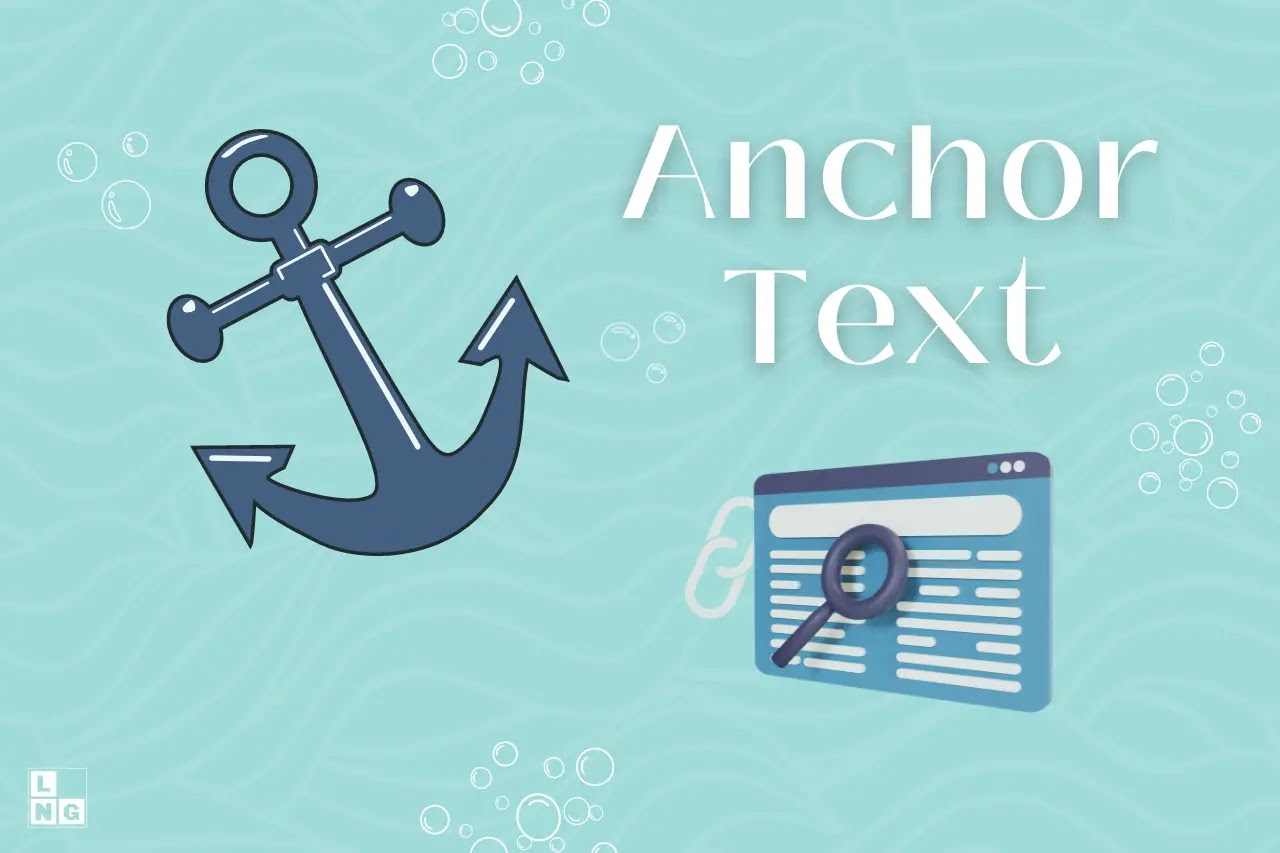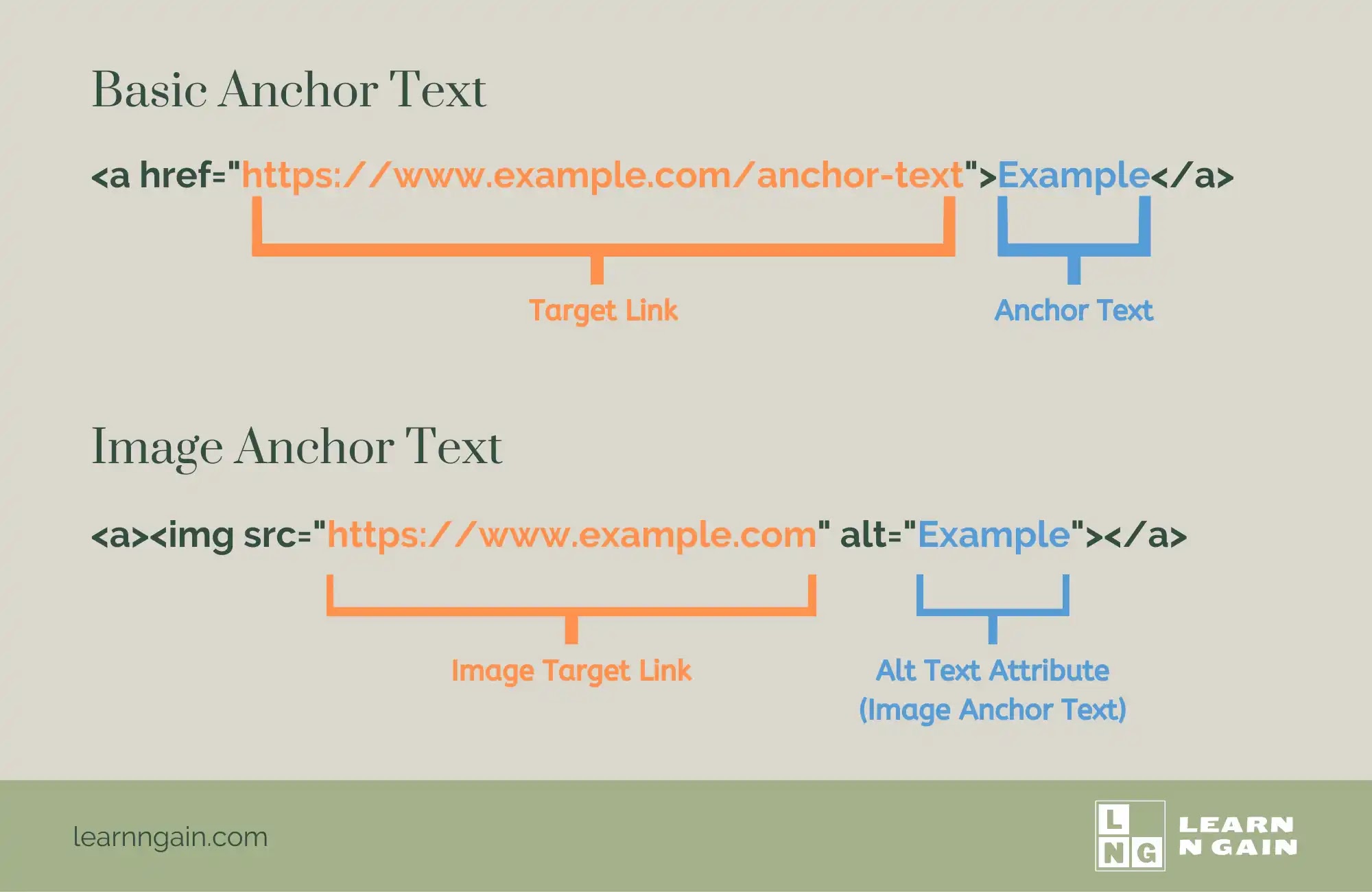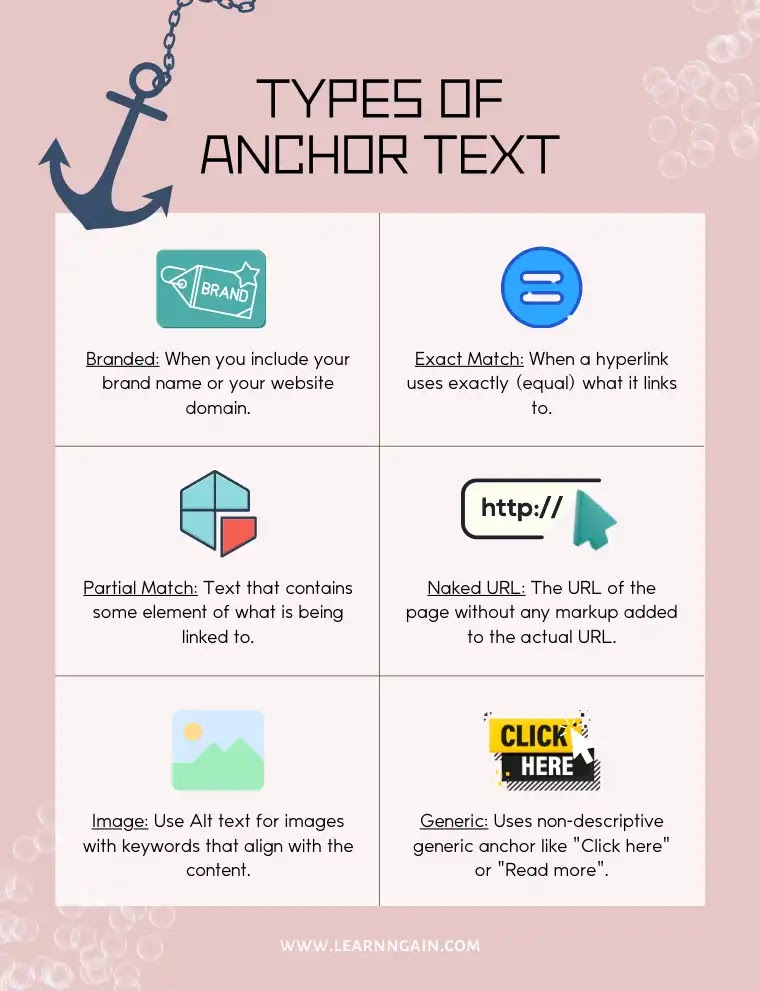 |
| What is Anchor Text in SEO and Why It's Important? |
You’ve probably heard of the term anchor text in passing while reading up on Search Engine Optimization (SEO). It refers to the blue and underlined text that appears in bold or italics in hyperlinks and it has gained popularity over the past few years, with more and more people learning about it. In this guide you’ll find everything you need to know about it, what is it? What are the types of it? How to use it? And why should you be concerned about what your anchor text looks like? Let’s take a look at the answers to these questions, and other factors that can influence your use of anchor text.
What is anchor text?
Anchor text is the clickable hyperlinked text that links to a different web page. In this way, it is like a reference to the word or phrase. For example, if you are reading this sentence and the words 'Learn N Gain Blog' are in bold blue lettering, then they probably would be anchor text.
It has become a critical part of search engine optimization (SEO) because Google uses anchor text as one factor when determining the ranking for any given website. That means that people who want their website to rank higher will use anchor texts with keyword phrases. This help makes sure that the keywords are used throughout many pages on your site.
Additionally, using more than one type of anchor text helps to ensure a wide variety of keywords and topics are used on your site so visitors can find what they're looking for faster.
Not all anchor texts have to be keywords. Anchor text should also include your brand name, category names, and call-to-action sentences. One great tip for creating excellent anchor text is to use semantically meaningful anchors whenever possible. When developing new content on your website, you should include at least three types of anchors so readers can easily find what they're looking for.
Why is anchor text important?
It is important for SEO because it increases the chance that you'll rank for a keyword when someone searches for it. So, choosing your anchor text can make or break your chances of ranking.
It is important because search engines rank the page higher if there is a link with text (the anchor text) that matches what they are looking for. This is because Google doesn't want you to have to scroll through endless pages of sites. When a user finds your site, they will be less likely to leave if your site has keywords in the anchor text that best match their search terms. With anchor text being an indication of relevancy, it's important not only to make sure the keyword is included in the anchor text but also to make sure it reflects what users would find on your website.
For example, if you're a travel agent and you're linking to your blog post about how to make money when traveling abroad, your anchor text should say something like how to make money when traveling abroad so that Google (or the other search engines) knows that this blog post is about how to make money when traveling abroad. If instead, it said why people travel, Google might know the subject matter but not why this particular blog post was relevant.
There are many ways to get links with good anchor texts. The easiest way is to create content that others will want to share with their audience. Quality content often leads to backlinks with good anchor texts such as click here, read more, or learn more.
 |
| The Structure of Anchor Text |
Types of anchor text
When you create links to other pages of your site, the phrase that introduces the page may be known as anchor text. Links can also lead to external sites. This text typically appears inside a link but may be placed outside of the link, depending on the format of the link you are using. When you optimize a website for search engines, it's important to use relevant keywords in your anchor text. If not, Google will not be able to index your site properly because it won't understand what the content of the linked page is about. As such, it'll display those results lower on search engine results pages (SERPs). There are different types of anchor text that provide varying degrees of impact on how your website ranks on SERPs.
1. Branded anchor text:
Branded anchor text includes your brand name, your website domain, or your product name.
Here’s an example:
I can use Learn N Gain as an anchor text to refer to the homepage of this blog.
2. Exact match anchor text:
A common type of anchor text is the exact match, which occurs when a hyperlink uses exactly what it links to as its textual target for an existing webpage.
In other words, the exact match anchor text is the text which matches an exact query, and it helps to show search engines that your web page is relevant to the link they're clicking on.
For example, if someone were linking to the blog post SEO Skills, from this blog post with anchor text SEO Skills, then that would constitute an example of an exact match.
3. Partial Match anchor text:
Partial Match anchor text is the text which contains some element of what is being linked to (only a part of it or a variation is included, and the exact keyword isn't included), and it helps boost your rankings when it comes to related phrases or queries.
A mixture of both types (Exact and Partial match anchor text) will help provide context for how and why people are linking to your website.
4. Naked-link (URL) anchor text:
The naked-link anchor text is just the URL of the page without any markup added to the actual URL.
For example "https://www.learnngain.com/2021/09/best-seo-tools.html".
It is not a good idea because you want your website visitors to understand what they're clicking on so that they aren't directed to something that doesn't interest them or offer what they were looking for. This will also lead them away from your website.
5. Image anchor text:
The anchor text of an image, or alt text, refers to the descriptive text written to accompany a photo. This text can be seen either by hovering over the photo with a mouse or after selecting the Alt option on mobile devices. While this feature may seem irrelevant at first, it has the potential to have a large-scale impact on search engine rankings if optimized properly. The HTML code for images includes its alt text field, which makes it possible to control what words are shown when an image is searched for online.
Simply fill out this field with keywords that best represent your content (such as On-Page and Off-Page SEO) and make sure you title your images appropriately for the best results! As anchor text, these words will appear alongside your thumbnail and play a significant role in how well your post ranks on Google Images. In other words, by adding keyword-rich anchor text to your images, you're telling Google that this is a relevant piece of information worth including in their search engine results.
6. Generic anchor text:
The Generic anchor text is a link that you get naturally by creating great content that attracts many people. When someone likes what they read, they'll often go to your website to learn more about your topic. When this happens, it means you have succeeded at meeting the needs of someone interested in your type of content. Your brand may also start to build up a lot of links because people will be linking back to your content from their own websites with links filled with non-descriptive generic anchor text like "click here" or "read more".
While Google doesn't rank these types of links as well as specific anchor texts related to your website, having a mix of different anchor texts could help keep rankings higher over time.
 |
| Types of Anchor Text |
Anchor text best practices
Most of the links on your website will be followed by anchor text, which is the text placed before a link to give the destination of that link context. The best practices for using it are pretty straightforward and we will go through them.
1. Make it short and descriptive:
Anchor text is what you see when you open a new window and it jumps to the page you were on before. This isn't just used for convenience, it can also affect your search engine optimization strategy and how people will find your website. Try using a keyword as the anchor text rather than something less descriptive like Click here, and also keep in mind not to use too long keywords to describe your anchors. This way, it helps clarify what your website offers prospective visitors and will help increase the likelihood of their click-through!
2. Be relevant:
Google pays attention to anchor text when it looks at a website to see how relevant the site is for a particular topic or keyword. When someone sees an anchor text link in their search results, they can decide whether they want to click on it and go to the related page. The more accurate and relevant your anchor text is, the more people will visit your site when they click on that link from their search result page. This means it's very important to use relevant keywords as your anchors because you want visitors who have these same interests.
3. Don’t deceive your readers:
Anchor text in SEO can also be used for something called keyword stuffing, which deceives readers by deliberately using spammy or irrelevant keywords over and over again to get higher rankings. This leads search engines to penalize your website by making it harder to rank higher. For example, if your anchor text is “chocolate recipes” but the linked website is about fashion.
4. Don't forget to use image alt tags:
It can be difficult to write about text online when you are trying to work with words. Rather than making things up, it is much easier to use images. Try using alt tags for images with keywords that align with the content of your blog post. These tags provide text descriptions for people viewing the image if their browser does not read aloud. This gives people an idea about what you are talking about without having to actually read anything!
5. Use different types of it:
Different types of anchor text (eg. branded, exact match, generic) provide different benefits to your website. The more variations you use, the better chance you have of ranking well on Google’s algorithm. This can improve organic rankings, which will eventually increase visitors who are interested in your content and improves the quality of traffic. Always use different types of anchor text for best SEO practices!
Final thoughts
Now you have a better idea of what anchor text in SEO is, how it can improve your site performance, and why it should be considered when designing your links. The most important thing you can do to optimize your anchor text is to make sure that it’s relevant and natural sounding. Keep it short, informative, and to the point, so readers can easily skim through it. Don't worry about keyword density too much as long as your anchor text reads smoothly. Finally, don't get yourself caught up with numbers because they're not all equal; just focus on the quality of what you write rather than how often keywords are used.
Finally, I would like to know your experiences with this blog post in the comments section below. If you find this article useful for you, you can share it on social networking sites and give the credits to our blog (Copyrights), and you can follow us to get the latest blog posts and be the first to know about them, and also you can suggest any new topics you want us to talk about.
